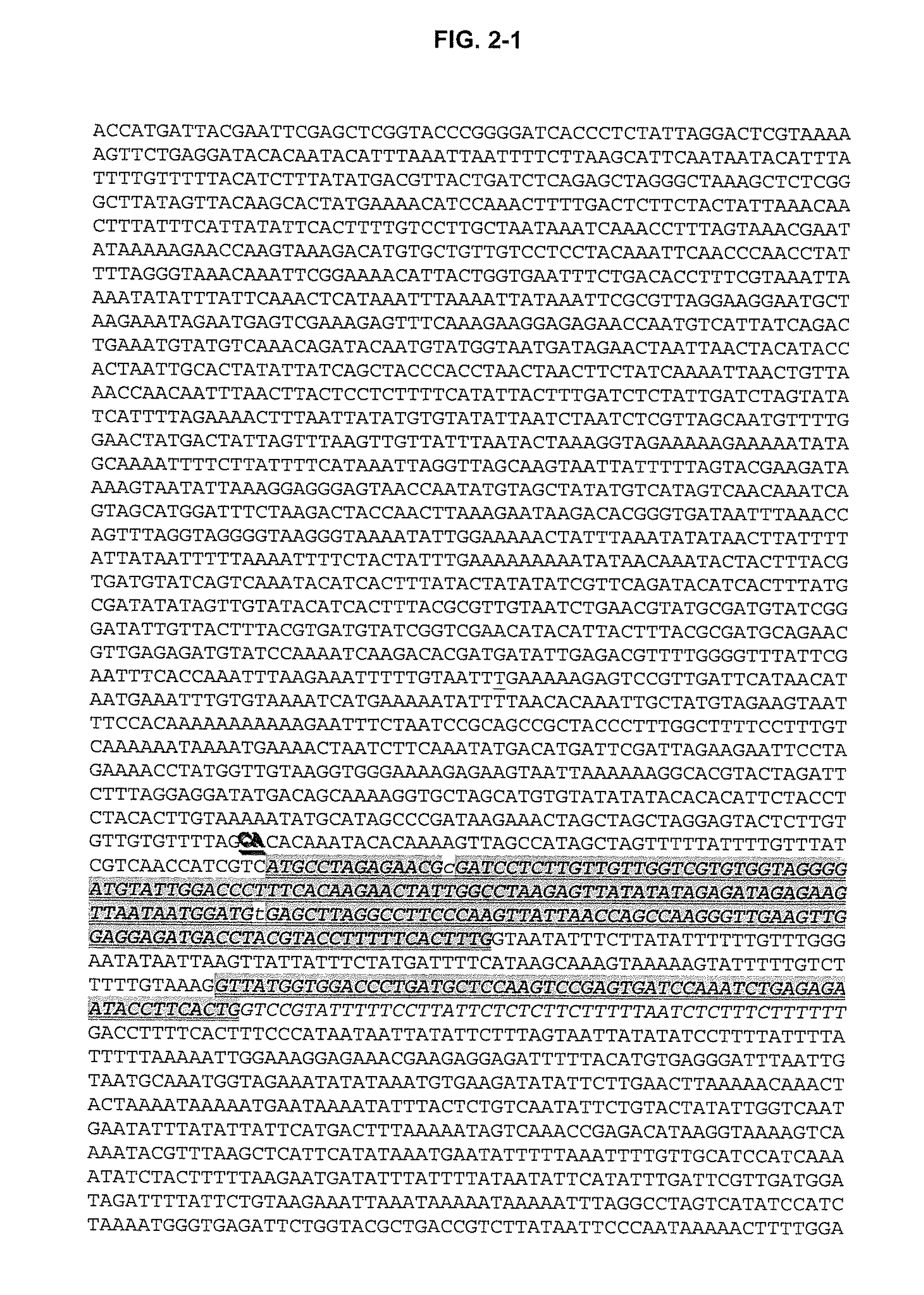Promotor sequence and gene construct for increasing crop yield in tomato
a technology of gene constructs and promotor sequences, applied in the field of promotor sequences and gene constructs for increasing crop yield in tomatoes, can solve problems such as hampered development of varieties with higher yields, and achieve the effect of increasing crop yields
- Summary
- Abstract
- Description
- Claims
- Application Information
AI Technical Summary
Benefits of technology
Problems solved by technology
Method used
Image
Examples
example 1
Cloning and Isolation of SP3Dpen
[0061]SP3D Solanum esculentum gene (accession number AY186735) has been used for cloning the Solanum pennelii la716 gene. A S. pennellii BAC library has been screened with primers SP3D-f2 / SP3D-r: 40 cycli at 92° C. 30″, 60° C. 30″ and 72° C. 60″ resulting in BAC52, 1c06e11 harbouring SP3Dpen (FIG. 1).
[0062]BAC51, 1c06e11 was subsequently double digested with BamHI / SpeI and ligated in pUC 18 XbaI / BamHI double digest to create sub clones. Subsequently, sub clones were screened with SP3D-f2 / SP3D-r marker to identify the individual clone harbouring SP3Dpen. Clone KEZ504 has been sequenced and it contained the complete SP3D gene / locus from S. pennellii, designated as SP3Dpen, SEQ ID NO: 6. (FIG. 2). Comparison of S. lycopersicum SP3D cDNA, accession number AY186735, with the S. pennellii SP3D cDNA revealed that SP3Dpen had 4 nucleotide changes. Two single nucleotide polymorphisms (SNP) are located in the first exon on position 15 (T=>C) and 120 (C=>T), the...
example 2
Causal SNP in Promoter, Wild Relatives
[0063]One of the determination keys of Solanum species is sympodial index. Species with two leaves between trusses (spi=2) are Solanum neorickii, Solanum chmielewskii, Solanum chilense, Solanum peruvianum, and Solanum pennellii. Species with three leaves between trusses (spi=3) are S. habrochaites, S. cheesmaniae, S. pimpinellifolium and S. lycopersicum.
[0064]To verify the hypothesis that spi=2 is caused by a change upstream of the gene several wild relatives have been studied. Fifty-three wild relatives of the mentioned species were re-sequenced using primers SP3D-10fa and dSP3D-r1. Of the group of 53 wild relatives, 11 represented S. cheesmaniae, 2 represented S. chilense, 7 represented S. habrochaites, 10 represented S. neorickii, 1 represented S. pennellii, 7 represented S. peruvianum, 11 represented S. chmielewskii, 1 represented S. lycopersicum, and 3 represented S. pimpinellifolium.
[0065]Sequence comparisons revealed a CA motif 62-61 nu...
example 3
Phenotypes of F1 Hybrids with and without SP3Dpen
[0066]Introgression line 49015-2 harbouring the SP3Dpen from S. pennellii la716 has been crossed with Enza Zaden S. lycopersicum lines OT1464 and OT1690. The resulting F1 hybrids have been backcrossed with OT1464 or selfed in the case of the OT1690 cross. Plants with SP3Dpen were selected with dCAPS marker dSP3D-1fr; primers dSP3D-f / dSP3D-r, PCR conditions 40 cycli at 92° C. 30″, 55° C. 60″ and 72° C. 60″, digested by HpyCH4V, separated on 3% ms-8 agarose (Hispanagar). Besides the dSP3D-1fr marker, marker assisted backcross has been used to identify the highest recurrent parent, as known for those who are skilled in the art, resulting in plant NT05-96e11 for the OT1464 background and NT05-108h10 and NT05-108e12 for the OT1690 background. These individual plants were 2 times selfed, selected again with dSP3D marker and by marker assisted backcross, resulting in plants 111B6 for the OT1464 background and plants 117F1 and 117G1 for the O...
PUM
| Property | Measurement | Unit |
|---|---|---|
| diameter | aaaaa | aaaaa |
| weight | aaaaa | aaaaa |
| size | aaaaa | aaaaa |
Abstract
Description
Claims
Application Information
 Login to View More
Login to View More - R&D
- Intellectual Property
- Life Sciences
- Materials
- Tech Scout
- Unparalleled Data Quality
- Higher Quality Content
- 60% Fewer Hallucinations
Browse by: Latest US Patents, China's latest patents, Technical Efficacy Thesaurus, Application Domain, Technology Topic, Popular Technical Reports.
© 2025 PatSnap. All rights reserved.Legal|Privacy policy|Modern Slavery Act Transparency Statement|Sitemap|About US| Contact US: help@patsnap.com



